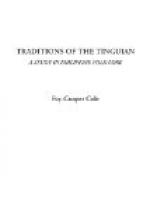The wealth of a person seems to have been, to a large extent, determined by the number of old jars in his possession. As at the present time, they formed the basis of settlement for feuds, as payment for a bride, and even figured in the marriage ceremony itself. The jars, as judged from their names, were evidently of ancient Chinese manufacture, and possessed power of speech and motion similar to that of human beings; but in a lesser measure the same type of jars have similar powers to-day. [47]
The use of gold and jewels seems to have been common in the old times; the latter are seldom seen in the district to-day, but the use of bits of gold in the various ceremonies is still common, while earrings of gold or copper are among the most prized possessions of the women. [48] Placer mining is well known to the Igorot of the south, who melt and cast the metal into various ornaments. So far as I am aware, this is not practiced by the present Tinguian, but may point back to a time when the industry was known in this region, or when trade relations with the south were much freer than in recent years.
The weapons of the warriors, which we are specifically told were of metal, are identical with those seen at the present time, while the methods of warfare agree with the accounts still told by the old men of their youthful exploits.
A survey of the tales brings out boldly the fact that a headhunt was one of the most important events in Tinguian life. To-day stress of circumstances has caused the custom to suffer a rapid decline, but even now heads are occasionally taken, while most of the old men have vivid recollections of the days when they fought “in the towns of their enemies.” A spirited account of a head celebration seen in the village of Lagangilang—from which ten of these tales were collected—will be found in the writings of La Gironiere, already referred to. [49] It is important to note that this account, as well as those secured from many warriors of the present generation, offers some striking differences to the procedure in the olden days, particularly as regards the disposal of the skulls. The tales tell of the heads being placed on the sagang [50] at the spring, at the gate, or about the town, after the celebration. Certain of the present villages make use of the sagang, but the more common type of head holder is the saloko, [51] which still figures in many ceremonies. However, the heads only remain in these receptacles until the day set for the festival. They are then carried to the centre of the village and there, amid great rejoicing, are cut open; the brains are removed and to them are added the lobes of the ears and joints of the little fingers, and the whole is then placed in the liquor, which is served to the dancers. Before the guests depart the skulls are broken into small pieces and a fragment is presented to each male guest, who carries it home and is thus often reminded of the valor of the takers. [52] A study of Tinguian beliefs furnishes an additional religious motive for the taking of heads, but with the people of Kadalayapan and Kaodanan revenge and the desire for renown were the prime incentives.




